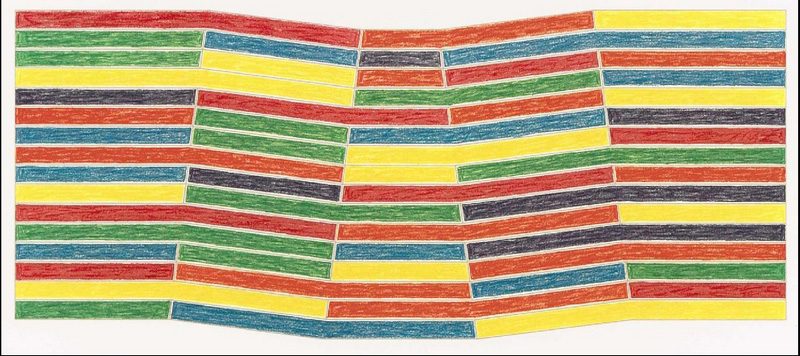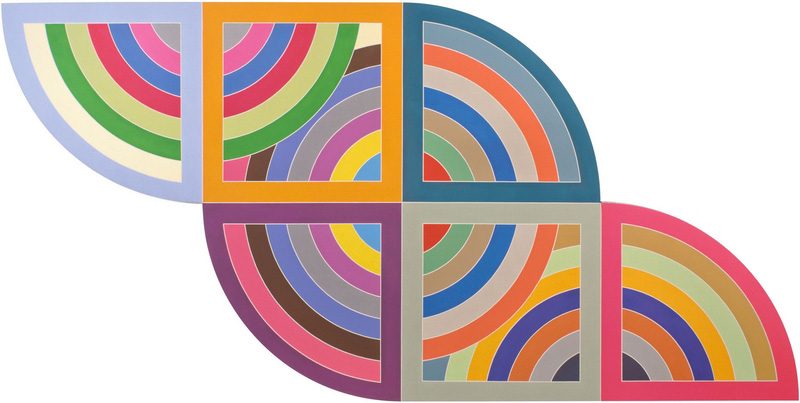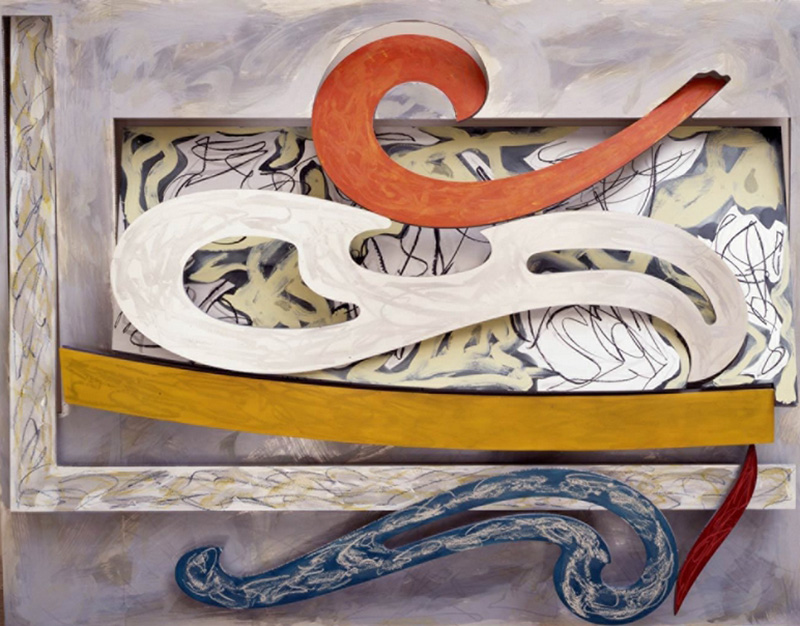TRACES: Frank Stella
 Today is the occasion to bear in mind Frank Stella (12/5/1936-4/5/2024), one of the most dominant and influential figures in Abstract Painting during the ‘60s through the ‘90s. Stella famously called a painting “A flat surface with paint on it, nothing more”, reflecting his view of art as an end in itself rather than a representation of emotional, intellectual, or physical states. This column is a tribute to artists, living or dead, who have left their mark in Contemporary Art. Through documents or interviews, starting with: moments and memories, we reveal out from the past-unknown sides of big personalities, who left their indelible traces in time and history…
Today is the occasion to bear in mind Frank Stella (12/5/1936-4/5/2024), one of the most dominant and influential figures in Abstract Painting during the ‘60s through the ‘90s. Stella famously called a painting “A flat surface with paint on it, nothing more”, reflecting his view of art as an end in itself rather than a representation of emotional, intellectual, or physical states. This column is a tribute to artists, living or dead, who have left their mark in Contemporary Art. Through documents or interviews, starting with: moments and memories, we reveal out from the past-unknown sides of big personalities, who left their indelible traces in time and history…
By Dimitris Lempesis
 Frank Stella was born in Malden, Massachusetts. He attended the Phillips Academy in Andover (1950-1954), where he studied painting with Patrick Morgan. Stella graduated from Princeton University with a bachelor of arts degree in history in 1958. Because Princeton did not offer a degree in studio art, his development during these years was largely the result of self-teaching. In 1959, several of his paintings were included in “Three Young Americans” at the Allen Memorial Art Museum, as well as in “Sixteen Americans” at the MoMA (1959–60), this exhibition established him as one of the most radical young artists working in the U.S.A. He instantly gained notoriety for his “Black Paintings”, a series of linear shapes and squares in various shades of black. A year later he had his first solo exhibition at Leo Castelli. A major accomplishment of Stella’s concern with shape was realized in 1966 in a series of paintings called the “Irregular Polygons”. In these he abandoned the imagery of stripes, choosing instead to create literal and depicted shapes of a wholly abstract variety. Beginning in 1967 Stella worked on a group of paintings known as the “Protractor Series”. Their imagery consisted of sweeping arcs of brilliant color. They marked a new direction in his work. In 1970, the Museum of Modern Art in New York gave Stella a retrospective. That same year, Stella introduced the “Polish Village” series, artwork made up of paper, felt, and painted canvas pasted on a stretched canvas. In 1975, he started the “Brazilian” constructions, first made of honeycomb aluminum. These were angular and linear, with hot colors. He followed this with the “Exotic Birds”, sculptures of both low and high relief from aluminum shapes that often had colors smeared on them. In 1977, he expanded to the “Indian Birds” series, in which the aluminum shapes jutted outward from curved sections of heavy steel mesh. This series eventually gave way to the “Circuit” series of 1981. These shapes were even more intricately interlaced than previous works, and full of glitter. The next year, the “Shards” series was introduced, composed of left over pieces of metal from previous works on a squared-off aluminum sheet. Wooden dowels, wire mesh and perforated strips of metal appeared in his next series, called “Playskool”, which Stella produced from 1982-83. The next year, he unveiled “Cones and Pillars”, rows of stripes in varying widths, almost resembling schematics in massive volume. Stella was very active in producing new works during the ‘90s. His art literally continued expanding, including murals 30 meter to a full block long. He also produced abstract sculptures. In 1990, he exhibited a block-long mural in Los Angeles. In 1993, his works became part of the architectural structure of the new Prince of Wales Theatre in Toronto. In 1995, Stella exhibited at the Knoedler Gallery in New York, and unveiled “Loohooloo”, a fiberglass mural 30 meter long that bulged out four feet in a smooth, pillow-like fashion. Every cm was covered with twisted grids, graphic designs, and graffiti-style markings. In 1995, he exhibited six large stainless steel sculptures, they invoked metaphors of both the landscape and industry of the area, suggesting smokestack-filled factories and rolling countryside. Stella died of lymphoma at his home in West Village, Manhattan, on May 4, 2024, at the age of 87,
Frank Stella was born in Malden, Massachusetts. He attended the Phillips Academy in Andover (1950-1954), where he studied painting with Patrick Morgan. Stella graduated from Princeton University with a bachelor of arts degree in history in 1958. Because Princeton did not offer a degree in studio art, his development during these years was largely the result of self-teaching. In 1959, several of his paintings were included in “Three Young Americans” at the Allen Memorial Art Museum, as well as in “Sixteen Americans” at the MoMA (1959–60), this exhibition established him as one of the most radical young artists working in the U.S.A. He instantly gained notoriety for his “Black Paintings”, a series of linear shapes and squares in various shades of black. A year later he had his first solo exhibition at Leo Castelli. A major accomplishment of Stella’s concern with shape was realized in 1966 in a series of paintings called the “Irregular Polygons”. In these he abandoned the imagery of stripes, choosing instead to create literal and depicted shapes of a wholly abstract variety. Beginning in 1967 Stella worked on a group of paintings known as the “Protractor Series”. Their imagery consisted of sweeping arcs of brilliant color. They marked a new direction in his work. In 1970, the Museum of Modern Art in New York gave Stella a retrospective. That same year, Stella introduced the “Polish Village” series, artwork made up of paper, felt, and painted canvas pasted on a stretched canvas. In 1975, he started the “Brazilian” constructions, first made of honeycomb aluminum. These were angular and linear, with hot colors. He followed this with the “Exotic Birds”, sculptures of both low and high relief from aluminum shapes that often had colors smeared on them. In 1977, he expanded to the “Indian Birds” series, in which the aluminum shapes jutted outward from curved sections of heavy steel mesh. This series eventually gave way to the “Circuit” series of 1981. These shapes were even more intricately interlaced than previous works, and full of glitter. The next year, the “Shards” series was introduced, composed of left over pieces of metal from previous works on a squared-off aluminum sheet. Wooden dowels, wire mesh and perforated strips of metal appeared in his next series, called “Playskool”, which Stella produced from 1982-83. The next year, he unveiled “Cones and Pillars”, rows of stripes in varying widths, almost resembling schematics in massive volume. Stella was very active in producing new works during the ‘90s. His art literally continued expanding, including murals 30 meter to a full block long. He also produced abstract sculptures. In 1990, he exhibited a block-long mural in Los Angeles. In 1993, his works became part of the architectural structure of the new Prince of Wales Theatre in Toronto. In 1995, Stella exhibited at the Knoedler Gallery in New York, and unveiled “Loohooloo”, a fiberglass mural 30 meter long that bulged out four feet in a smooth, pillow-like fashion. Every cm was covered with twisted grids, graphic designs, and graffiti-style markings. In 1995, he exhibited six large stainless steel sculptures, they invoked metaphors of both the landscape and industry of the area, suggesting smokestack-filled factories and rolling countryside. Stella died of lymphoma at his home in West Village, Manhattan, on May 4, 2024, at the age of 87,










